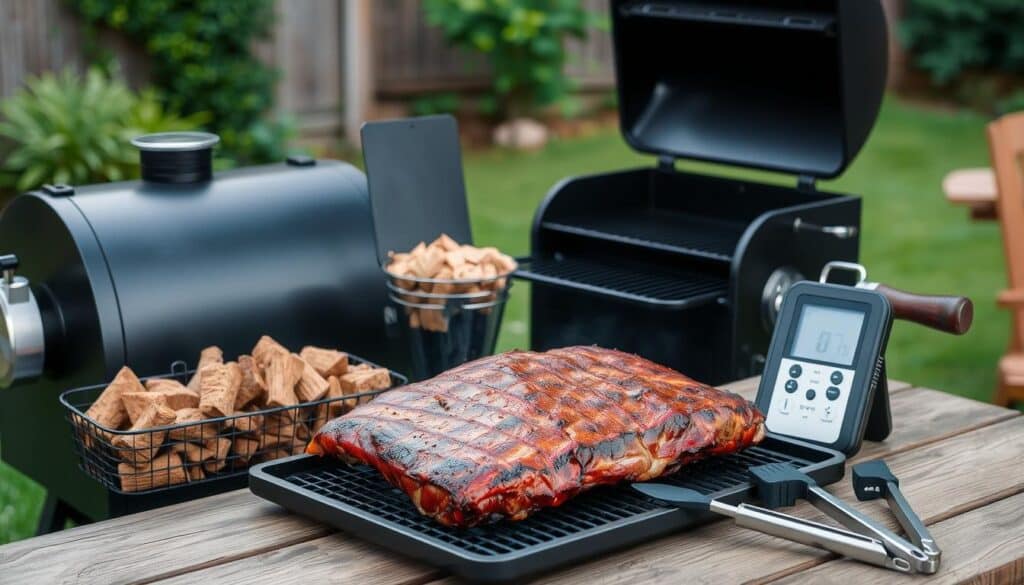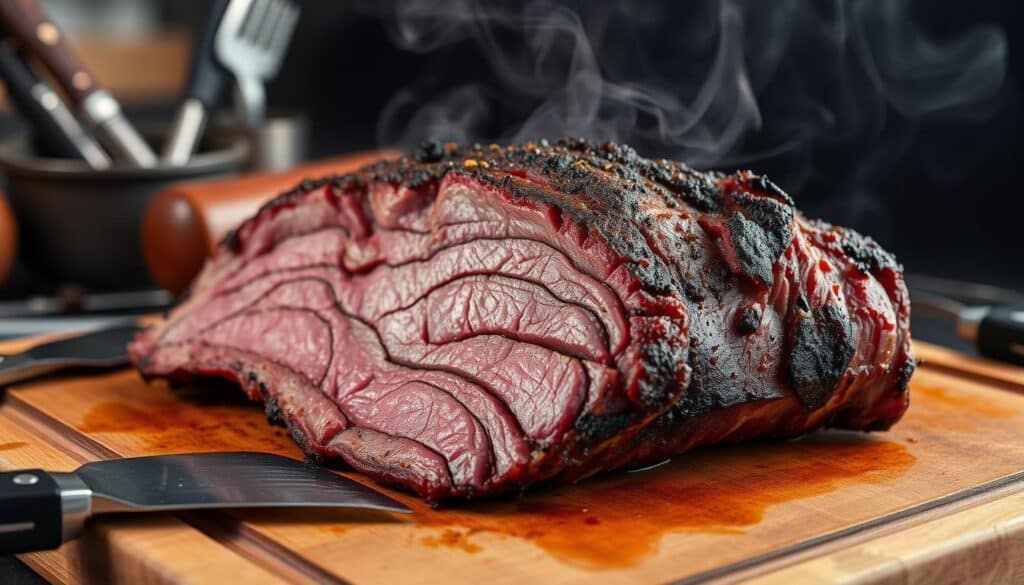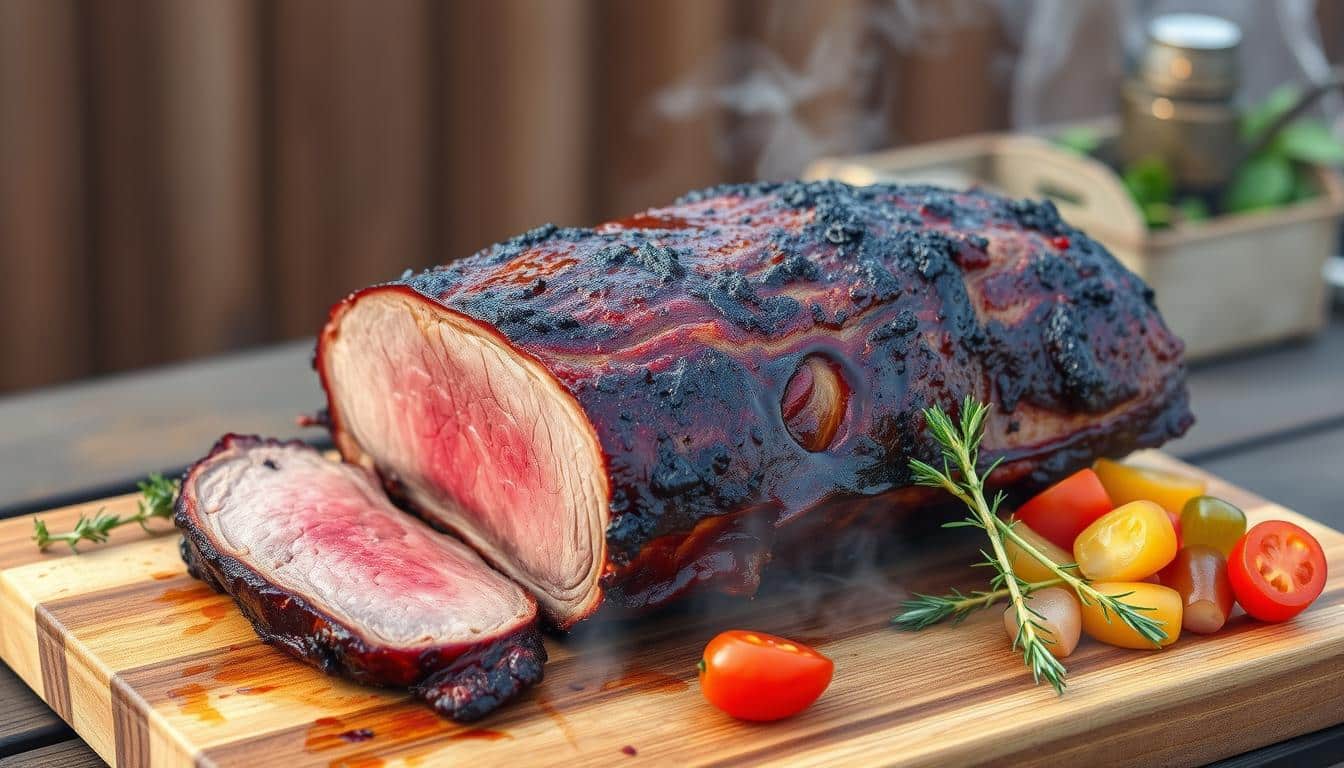For BBQ lovers, mastering smoked brisket recipe is a rewarding challenge. This guide will help you make the perfect smoked brisket. We’ll cover choosing the right cut and the smoking process. Our expert tips will ensure your brisket is a hit at any BBQ.For a sweet finish to your BBQ feast, try our Dessert & Juices Recipes, perfect for rounding off your meal. View Recipes.
Key Takeaways
- Learn how to select the best brisket cut and quality grade for optimal results
- Understand the essential equipment and tools needed for smoking brisket at home
- Discover the step-by-step process for preparing, seasoning, and smoking the perfect brisket
- Explore wood selection and smoke management techniques to enhance the flavor profile.For a creative twist on comfort food, pair your brisket with our The French Onion Soup Burger, a fusion of flavors. View Recipe.
- Master the Texas-style smoking approach, including managing the stall phase and achieving the perfect bark
Understanding Brisket: Cuts and Quality Selection
When it comes to smoked beef brisket, knowing the different cuts and quality grades is key. This knowledge helps you pick the best brisket for your smoking project.
Prime vs. Choice vs. Select Grades
The USDA has three main quality grades for beef: Prime, Choice, and Select. Prime brisket is the highest quality, with lots of marbling. This makes it tender, juicy, and full of flavor. Choice grade brisket is also great, with good marbling and taste. Select grade brisket is cheaper but might be less tender and needs more care during beef brisket smoking.
Flat Cut vs. Point Cut Differences
Brisket has two muscles: the flat cut and the point cut. The flat cut is leaner and rectangular, while the point cut is fattier. Many pitmasters prefer the whole packer cut, which includes both, for the best texture and flavor.
What to Look for When Buying Brisket
- Choose a brisket with a deep red color and lots of marbling.
- Look for a brisket with a thick, even fat cap to keep it moist.
- Avoid briskets with too much silver skin or connective tissue, as they can be tough.
- Consider the size of the brisket, as larger ones (10-12 pounds) offer more servings and better bark.
By understanding the different cuts and quality grades of beef brisket, you’ll be ready to pick the perfect cut for your smoked brisket seasoning and beef brisket smoking project.
| Cut | Description | Recommended Use |
|---|---|---|
| Flat Cut | Leaner, rectangular portion of the brisket | Ideal for slicing and serving |
| Point Cut | Thicker, fattier section of the brisket | Perfect for burnt ends and chopped brisket |
| Whole Packer Cut | Includes both the flat and point cuts | Provides the best balance of texture and flavor |
“The secret to a great smoked brisket is in the selection and preparation of the meat. Understanding the different cuts and quality grades is the first step towards barbecue perfection.”
Essential Equipment for Smoking the Perfect Brisket
To make the ultimate smoked brisket recipe, you need more than a great recipe. The right equipment is key. From the smoker type to the wood choice, each part is vital. They help create the perfect smoke, flavor, and tender texture.
Smoker Types and Temperature Control
The smoker you pick can greatly affect your brisket’s taste. Charcoal and electric smokers are common, but pellet grills or dedicated smokers are better. These offer precise temperature control, keeping the brisket at the perfect temperature.
- Pellet Grills: These use wood pellets for smoke and heat, ensuring consistent temperatures.
- Dedicated Smokers: These, like offset or vertical cabinet smokers, are made for slow cooking brisket.
Wood Selection for Smoke Flavor
The wood you choose greatly affects your brisket’s flavor. Here are some top picks for wood for smoking brisket:
- Oak: It gives a rich, robust taste.
- Mesquite: Offers a bold, sweet, and earthy flavor.
- Hickory: Provides a strong, bacon-like smokiness.
Try different wood mixes to find the perfect smoke flavor for your brisket.
“The key to great smoked brisket is finding the right balance between temperature control and wood selection. With the right equipment, you’ll be well on your way to perfecting the art of low-and-slow smoking.”

Having the right tools and accessories is essential for perfect smoked brisket. Invest in quality equipment and learn about wood selection. This way, you’ll make delicious, competition-worthy brisket every time.
The Ultimate Smoked Brisket Recipe: Step-by-Step Guide
Smoking a perfect brisket is an art form. With the right approach, you can master it. Our step-by-step guide will help you achieve the ultimate smoked brisket.
Trimming and Preparation
Begin by trimming the brisket to remove excess fat and silver skin. This makes seasoning and smoke penetrate better. Make sure the brisket is at room temperature before seasoning for even cooking.
Seasoning and Dry Rub Application
Apply your favorite smoked brisket rub all over the brisket. This creates a flavorful crust and keeps the meat moist during smoking.
Temperature Control and Monitoring
Keep your smoker at a consistent temperature, between 225°F to 275°F. Use a meat thermometer to check the brisket’s internal temperature. Aim for 195°F to 205°F for the best texture and flavor.
| Temperature Range | Ideal Brisket Smoking Time |
|---|---|
| 225°F to 250°F | 10-12 hours |
| 250°F to 275°F | 8-10 hours |
The brisket smoking time varies based on size, thickness, and your smoker’s conditions.
“The key to a perfect smoked brisket is patience and attention to detail. Stick to the right temperature and monitor the brisket smoking time closely for mouthwatering results.”
Wood Selection and Smoke Management
As passionate BBQ enthusiasts, we know the right wood for smoking brisket is key. It makes all the difference in getting that perfect smoky taste. Whether you’re an experienced pit master or new to BBQ, learning about wood selection and smoke management is important.
For wood for smoking brisket, some top picks include:
- Hickory: It gives a strong, bacon-like smokiness that goes great with beef.
- Oak: It offers a milder, balanced smoke flavor that lets the brisket’s natural taste stand out.
- Mesquite: It brings a strong, intense smokiness but use it carefully as it can be too much.
- Fruit woods like apple, cherry, or pecan: They add a sweet, fruity taste that complements the smoked brisket marinade well.
Managing smoke well is essential for that perfect pink smoke ring and consistent flavor in your brisket. Try different wood mixes, watching the smoke’s strength and adjusting your smoker’s vents to keep a steady, slow burn for hours.
“The secret to the perfect smoked brisket lies in the interplay of wood selection and smoke management. Get it right, and you’ll be rewarded with a truly transcendent barbecue experience.”
Mastering wood for smoking brisket and smoked brisket marinade will help you make brisket that everyone will love. So, fire up your smoker, grab your favorite wood chips, and get ready to improve your BBQ skills!
Mastering the Texas-Style Smoking Technique
Learning to smoke the perfect texas style smoked brisket is a journey. It’s all about managing the stall phase, using the right wrapping methods, and getting that perfect bark. These are key steps taught by pitmasters from Texas.
The Stall Phase Management
The “stall” phase is a tricky part of smoking. It’s when the brisket’s temperature seems stuck for hours. Texas pitmasters know how to get past this by watching the temperature and adjusting the airflow. They also use the “Texas crutch” to keep the brisket moving towards doneness.
Wrapping Methods and Timing
Wrapping the brisket is a key part of Texas-style smoking. The choice of wrapping material and when to wrap it can greatly affect the brisket’s texture and taste. We’ll look at different wrapping methods and when to use them for the best results.
Achieving the Perfect Bark
The perfect Texas-style smoked brisket has a beautiful, mahogany bark. This bark is the result of careful smoking, from the dry rub to the temperature and smoke control. We’ll share tips on how to create a bark that makes your brisket stand out.
By mastering the Texas-style smoking technique, you’ll make your texas style smoked brisket unforgettable. Your guests will love the juicy brisket and the amazing bark. It’s a recipe for a true barbecue masterpiece.
Determining Doneness and Resting Period
Getting the right brisket smoking time and brisket smoking temperature is key for a delicious, tender, and flavorful brisket. We’ll show you how to check if your brisket is done and why resting it is important.
The internal temperature of the brisket tells you if it’s done. You want it between 195°F and 205°F. This ensures the meat is tender. Use a meat thermometer to check the temperature, making sure it’s in the thickest part without hitting bone.
- Brisket is considered done when it reaches an internal temperature of 195°F to 205°F.
- Insert a meat thermometer into the thickest part of the brisket, avoiding any bones.
- Monitor the temperature closely during the final stages of the cook to achieve the perfect doneness.
After the brisket hits the right temperature, let it rest. It should rest for at least 30 minutes, but 60 minutes or more is better. This lets the juices spread out, making the meat juicier and tastier.
“Resting your brisket is just as important as the smoking process itself. It allows the meat to relax and the juices to redistribute, ensuring a truly exceptional final dish.”
While the brisket rests, its temperature will go up a bit. So, wait until it’s just right before taking it out of the smoker. With patience and care, you’ll get a brisket that’s perfectly cooked and delicious.

Professional Tips for Slicing and Serving
Proper slicing is key to showing off your Texas-style smoked brisket. Always cut against the grain for tender and juicy slices. Use a sharp knife and take your time for even slices.
Proper Slicing Techniques
Start by finding the meat’s grain, which runs along the brisket’s length. Slice across the grain for tender bites. Keep each slice about 1/4 to 1/2 inch thick for a neat look.
Presentation and Accompaniments
Place your smoked brisket slices on a warm platter. Add fresh herbs or a drizzle of cooking liquid for extra flavor. Serve with creamy coleslaw, corn bread, and tangy barbecue sauce for a complete meal.For an indulgent breakfast alternative, explore our Ultimate Brioche French Toast Recipe as a unique side. View Recipe.

